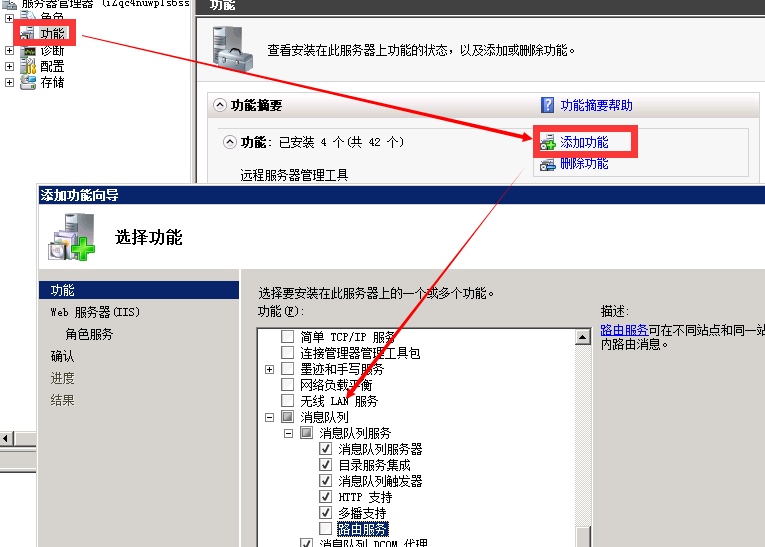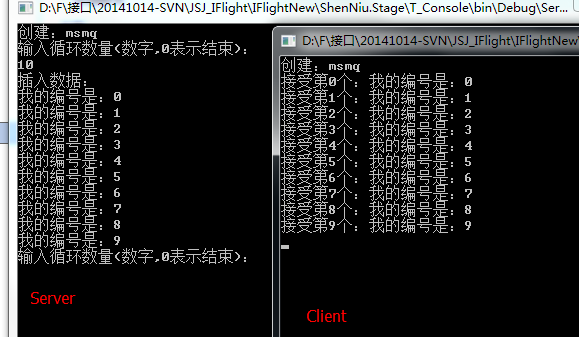隊列工廠之(MSMQ)
最近vs2017神器正式版發布讓人很是激動,vs2017支持了很多語言的開發,從前端-後端-底層的支持,堪稱是工具中的神器;netcore我喜愛的架構之一也得到了大力的宣傳,應群友的邀請將在隊列工廠(msmq,redis,rabbitmq)一些列文章過後,繼續增加.netcore方面的文章,只為.netcore發展更好貢獻一份微弱的力量;本章內容分享的是隊列(msmq,redis,rabbitmq)封裝的隊列工廠之MSMQ希望大家能夠喜歡,也希望各位多多"掃碼支持"和"推薦"謝謝!
創建隊列工廠QueueReposity<T>
. 隊列公共操作接口IQueue
. 配置文件操作類ConfClass<T>
. 非安全單例創建隊列實例
Win7和Server2008安裝MSMQ支持
MSMQ測試用例(服務端+客戶端)
下面一步一個腳印的來分享:
創建隊列工廠QueueReposity<T>
首先,因為這裏需要統一封裝幾個常用的隊列方式的用法,因此采用了簡單工廠模式,所以有了QueueReposity<T>;
. 隊列公共操作接口IQueue
工廠模式的特性創建實例,因為這裏封裝的都是隊列,故而能提取出統一的規則來,因此定義了如下接口(這裏沒有考慮一些隊列兼容的異步方法請忽略):
/// <summary>
/// 隊列公共操作
/// </summary>
public interface IQueue : IDisposable
{
/// <summary>
/// 創建隊列
/// </summary>
void Create();
/// <summary>
/// 總數
/// </summary>
/// <returns></returns>
int Total();
/// <summary>
/// 讀取一個隊列
/// </summary>
/// <returns></returns>
Message Read();
///// <summary>
///// 讀取多個隊列
///// </summary>
///// <returns></returns>
//List<Message> ReadAll();
/// <summary>
/// 寫入隊列
/// </summary>
/// <returns></returns>
bool Write(string content, string name = "");
}. 配置文件操作類ConfClass<T>
因為每個隊列的都有自己的配置信息,因此封裝了統一管理的配置文件讀取類ConfClass<T>,來讀取配置在同一個xml文件中的配置信息,如下封裝了自定義配置文件的屬性和讀取方法:
#region 文件操作類
/// <summary>
/// 配置文件操作類
/// </summary>
/// <typeparam name="T"></typeparam>
public class ConfClass<T> where T : class,new()
{
public ConfClass() {
var apiNodeName = this.GetType().Name;
Reader(apiNodeName);
}
#region 單例模式
public static readonly object Singleton_Lock = new object();
/// <summary>
/// 單例對象
/// </summary>
private static T t = default(T);
/// <summary>
/// 通過方法獲取單例
/// </summary>
/// <param name="t"></param>
/// <returns></returns>
public static T GetInstance(T t)
{
t = t ?? new T();
return t;
}
/// <summary>
/// 通過屬性獲取單例(在繼承的時候使用)
/// </summary>
public static T Current
{
get
{
t = t ?? new T();
return t;
}
}
#endregion
#region 配置文件操作
#region 配置文件屬性
/// <summary>
/// 配置文件地址
/// </summary>
//public string ConfPath = Path.Combine(AppDomain.CurrentDomain.BaseDirectory, "Conf", "ShenNiuApi.xml");
public string ConfPath = @"C:\Conf\ShenNiuApi.xml";
/// <summary>
/// 配置文件父節點名稱
/// </summary>
public string ConfParentNodeName = "ShenNiuApi";
/// <summary>
/// 配置文件內容
/// </summary>
public string ConfContent { get; set; }
/// <summary>
/// 配置文件文檔doc對象
/// </summary>
public XmlDocument doc { get; set; }
/// <summary>
/// 賬號
/// </summary>
public string UserName { get; set; }
/// <summary>
/// 密碼
/// </summary>
public string UserPwd { get; set; }
/// <summary>
/// 接口地址
/// </summary>
public string ApiUrl { get; set; }
/// <summary>
/// 秘鑰
/// </summary>
public string ApiKey { get; set; }
#endregion
public ConfClass(string ConfPath, string ConfParentNodeName="")
{
this.ConfPath = string.IsNullOrWhiteSpace(ConfPath) ? this.ConfPath : ConfPath;
this.ConfParentNodeName = string.IsNullOrWhiteSpace(ConfParentNodeName) ? this.ConfParentNodeName : ConfParentNodeName;
var apiNodeName = this.GetType().Name;
Reader(apiNodeName);
}
/// <summary>
/// 讀取配置信息
/// </summary>
/// <param name="apiNodeName"></param>
public void Reader(string apiNodeName)
{
try
{
if (string.IsNullOrWhiteSpace(ConfPath) || string.IsNullOrWhiteSpace(ConfParentNodeName))
{
throw new Exception("配置文件地址或者配置文件父節點名稱不能為空");
}
if (!File.Exists(ConfPath)) { return; }
//獲取配置文件信息
using (StreamReader reader = new StreamReader(ConfPath))
{
this.ConfContent = reader.ReadToEndAsync().Result;
}
if (string.IsNullOrWhiteSpace(this.ConfContent)) { return; }
//加入doc中
this.doc = new XmlDocument();
this.doc.LoadXml(this.ConfContent);
//解析
var parentNode = string.Format("{0}/{1}", this.ConfParentNodeName, apiNodeName);
var apiNode = this.doc.SelectSingleNode(parentNode);
if (apiNode == null) { throw new Exception("未能找到" + parentNode + "節點"); }
this.UserName = apiNode.SelectSingleNode("UserName").InnerText;
this.UserPwd = apiNode.SelectSingleNode("UserPwd").InnerText;
this.ApiUrl = apiNode.SelectSingleNode("ApiUrl").InnerText;
this.ApiKey = apiNode.SelectSingleNode("ApiKey").InnerText;
}
catch (Exception ex)
{
throw new Exception("加載配置文件" + this.ConfPath + "異常:" + ex.Message);
}
}
#endregion
}
#endregion這個配置文件的類主要運用在隊列實例繼承上,只要繼承了默認就會讀取響應的配置節點信息;配置xml文件默認存儲的地址: C:\Conf\ShenNiuApi.xml ,最大父節點名稱默認:ShenNiuApi,格式如下所示:
<ShenNiuApi>
<QMsmq>
<UserName></UserName>
<UserPwd></UserPwd>
<ApiUrl>.\Private$\MyMsmq</ApiUrl>
<ApiKey></ApiKey>
</QMsmq>
</ShenNiuApi>. 非安全單例創建隊列實例
由於工廠都是專門用來提供實例的存在,創建實例的模式也有很多這種,這裏我選擇的是非安全單例創建隊列實例,所有在ConfClass類中默認加入了單例模式:
#region 單例模式
public static readonly object Singleton_Lock = new object();
/// <summary>
/// 單例對象
/// </summary>
private static T t = default(T);
/// <summary>
/// 通過方法獲取單例
/// </summary>
/// <param name="t"></param>
/// <returns></returns>
public static T GetInstance(T t)
{
t = t ?? new T();
return t;
}
/// <summary>
/// 通過屬性獲取單例(在繼承的時候使用)
/// </summary>
public static T Current
{
get
{
t = t ?? new T();
return t;
}
}
#endregion因此這裏所說的工廠模式通過泛型傳遞類型,再創建實例的具體代碼只有這麽點,簡短精煉:
/// <summary>
/// 隊列工廠
/// </summary>
public class QueueReposity<T> where T : class,IQueue, new()
{
public static IQueue Current
{
get
{
return PublicClass.ConfClass<T>.Current;
}
}
}Win7和Server2008安裝MSMQ支持
上面分享的是隊列工廠的結構,到這裏就要開始我們的第一個MSMQ隊列的安裝和封裝分享了;首先來看Win7測試環境上怎麽安裝MSMQ的支持:開始菜單-》控制面板-》程序和功能:

-》打開或關閉Windows功能-》勾選如圖所示隊列安裝組件:

-》確定等待安裝完成;到此win7安裝msmq就完成了,因為msmq是系統默認的所以安裝起來很方便,當然server2008也差不多,按照如下操作安裝(這裏我使用租的阿裏雲Server2008R2服務器為例):開始-》控制面板-》程序(下面的打開或關閉Window功能)->功能-》添加功能-》消息隊列:

在server上安裝的步驟基本沒啥變化,是不是很簡單;安裝完成後這樣你的電腦或服務器就支持msmq了,此刻的你是不是很興奮,覺得又能學到新東西了呵呵;
MSMQ測試用例(服務端+客戶端)
首先,這裏我用控制臺程序做測試用例,我分為客戶端和服務端,用服務端通過分裝的插入隊列方法插入數據,然後通過客戶端讀取隊列信息,先來上個圖撐撐場面吧:

這裏我創建了MSMQ的分裝類 public class QMsmq : PublicClass.ConfClass<QMsmq>, IQueue 實現了隊列接口IQueue和繼承配置文件類ConfClass<QMsmq>,此時具體的方法體如下:
public class QMsmq : PublicClass.ConfClass<QMsmq>, IQueue
{
private MessageQueue _msmq = null;
public void Create()
{
if (string.IsNullOrWhiteSpace(this.ApiUrl)) { throw new Exception("創建隊列需要指定隊列:地址"); }
_msmq = MessageQueue.Exists(this.ApiUrl) ?
new MessageQueue(this.ApiUrl) :
_msmq ?? MessageQueue.Create(this.ApiUrl);
//設置數據格式
_msmq.Formatter = new XmlMessageFormatter(new Type[] { typeof(string) });
}
public int Total()
{
if (_msmq == null) { throw new Exception("請先創建隊列"); }
return _msmq.GetAllMessages().Length;
}
public Message Read()
{
try
{
if (_msmq == null) { throw new Exception("請先創建隊列"); }
//60s超時
return _msmq.Receive(TimeSpan.FromSeconds(60));
}
catch (Exception ex)
{
throw new Exception(ex.Message);
}
}
//public List<Message> ReadAll()
//{
// try
// {
// if (_msmq == null) { throw new Exception("請先創建隊列"); }
// var messages = _msmq.GetAllMessages();
// return messages.ToList();
// }
// catch (Exception ex)
// {
// throw new Exception(ex.Message);
// }
//}
public bool Write(string content, string name = "")
{
try
{
if (_msmq == null) { throw new Exception("請先創建隊列"); }
if (string.IsNullOrWhiteSpace(content)) { throw new Exception("填充內容不能為空"); }
var message = new Message();
message.Body = content;
message.Label = name;
_msmq.Send(message);
return true;
}
catch (Exception ex)
{
throw new Exception(ex.Message);
}
}
public void Dispose()
{
if (_msmq != null)
{
_msmq.Close();
_msmq.Dispose();
_msmq = null;
}
}
}到這裏我們的MSMQ簡單封裝代碼已經完成了,咋們再來通過控制臺調用下這個隊列客戶端代碼:
class Program
{
static void Main(string[] args)
{
Client();
}
/// <summary>
/// 客戶端
/// </summary>
private static void Client()
{
//實例化QMsmq對象
var msmq = QueueReposity<QMsmq>.Current;
try
{
Console.WriteLine("創建:msmq");
msmq.Create();
while (true)
{
try
{
var result = msmq.Read();
Console.WriteLine(string.Format("接受第{0}個:{1}", result.Label, result.Body));
}
catch (Exception ex)
{ Console.WriteLine("異常信息:" + ex.Message); }
}
}
catch (Exception ex)
{
throw ex;
}
finally
{
Console.WriteLine("釋放。");
msmq.Dispose();
}
}
}這裏能夠看出客戶端代碼中使用MSMQ步驟主要有:QueueReposity<QMsmq>.Current工廠創建自定義隊列實例-》Create()創建-》Read()讀取-》Dispose()釋放mq,流程還算清晰吧;如下服務端代碼:
class Program
{
static void Main(string[] args)
{
Server();
}
/// <summary>
/// 服務端
/// </summary>
private static void Server()
{
//實例化QMsmq對象
var msmq = QueueReposity<QMsmq>.Current;
try
{
Console.WriteLine("創建:msmq");
msmq.Create();
var num = 0;
do
{
Console.WriteLine("輸入循環數量(數字,0表示結束):");
var readStr = Console.ReadLine();
num = string.IsNullOrWhiteSpace(readStr) ? 0 : Convert.ToInt32(readStr);
Console.WriteLine("插入數據:");
for (int i = 0; i < num; i++)
{
var str = "我的編號是:" + i;
msmq.Write(str, i.ToString());
Console.WriteLine(str);
}
} while (num > 0);
}
catch (Exception ex)
{
}
finally
{
Console.WriteLine("釋放。");
msmq.Dispose();
}
Console.ReadLine();
}
}服務端的步驟幾乎和客戶端差不多,區別在於一個讀取一個寫入,服務端步驟:QueueReposity<QMsmq>.Current工廠創建自定義隊列實例-》Create()創建-》Write()寫入-》Dispose()釋放mq;以上對MSMQ的代碼分享和環境搭建講解,希望能給您帶來好的幫助,謝謝閱讀;
本文出自 “神牛步行3博客” 博客,請務必保留此出處http://shenniu003.blog.51cto.com/3316359/1923484
隊列工廠之(MSMQ)
